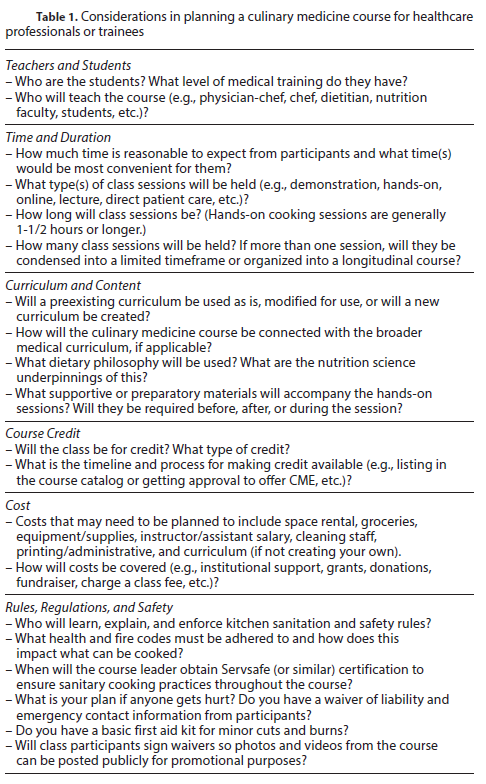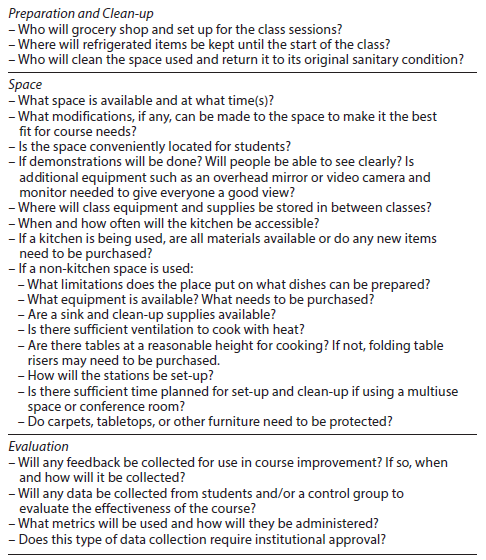Culinary Medicine Basics and Applications in Medical Education in the United States
Culinary medicine is an evidence-based field of medicine that combines nutrition science and culinary arts to create food that is delicious, promotes wellness, and prevents and treats disease. The field was created to address the missed opportunities presented by nutrition education at all levels of medical education and in medical practice. Current nutrition curricula are limited in time, scope, and content applicable to direct patient care. An additional barrier to adequate and effective nutrition education in medical school is that the majority of instruction occurs in the preclinical years, disconnected from active patient care. Moreover, the content is primarily comprised on topics, such as biochemistry, molecular biology, and micronutrient deficiencies, which are of little use when con- ducting dietary counseling with patients.
It is difficult to parse the limited nutrition offerings in most medical schools with data identifying diet as the single most significant risk factor for morbidity and mortality in the U.S. [1]. There has never been a more important time to equip physicians with the abilities to effectively evaluate, prevent, and treat food-related disease. Skills required to do this include taking a dietary history, assessing food access and cultural aspects of diet, motivational interviewing around making healthy dietary changes, and counseling on how to cook and eat healthy, delicious food that is accessible in terms of budget, time, skills, and other resources.
Culinary medicine is a hands-on, practical approach to nutrition education that brings students into the kitchen to learn how to prepare delicious, healthy food while simultaneously learning key nutrition lessons. It moves nutrition education away from a focus on nutrients towards a focus on food. This, in turn, aligns the healthcare professional’s approach to dietary counseling with the way that patients understand it best.


The first nutrition elective with a cooking focus held in a U.S. medical school was taught in 2003 at the State University of New York- Upstate campus [2]. However, culinary medicine courses started to become more widely available in the past five years, due largely to the opening of the Goldring Center for Culinary Medicine in 2013 at Tulane University School of Medicine. Tulane’s culinary medicine curriculum is the most widely used in medical education; to date, the program has been licensed to 39 medical schools across the U.S. [3, 4]. A separate, novel curriculum was developed in 2016 by the author and colleagues at Stanford University School of Medicine [5]. The course is taught as a quarter-long elective by physician-chefs using a blended classroom approach. Evaluation of knowledge, attitudes, and behaviors around cooking, eating, and patient dietary counseling have been compared between students and waitlisted controls. Preliminary data analysis showed significant improvements in numerous areas including basic cooking techniques, health eating behaviors, and confidence in planning balanced meals [5].
As the number of culinary medicine courses grows among medical education programs, so do the number of approaches to teaching the topic. Courses range in number of classes, placement in the larger medical school curriculum, and type of instructor. No single dietary philosophy is employed, and classes take place in settings ranging from pop-up conference room kitchens to dedicated teaching kitchens. This flexibility affords nearly any medical practice or educational setting the ability to provide some amount of culinary medicine content. Other important considerations when planning a culinary medicine course are shown in the Table 1. Beyond medical school, residency programs – primarily those focused on prevention and lifestyle medicine – are also beginning to add culinary medicine classes to their curricula. Culinary medicine continuing medical education opportunities have been available since the annual Healthy Kitchens, Healthy Lives conference began in 2007 in California. Additionally, some large healthcare systems offer physicians on-site culinary medicine courses, such as Kaiser Permanente’s Thrive Kitchen [3]. Finally, those seeking in-depth training can become certified in culinary medicine through programs like the Certified Culinary Medicine Specialist from Tulane or the Plant-based Nutrition Certificate from Cornell.
Culinary medicine makes nutrition education practical and directly applicable to the lives of both practitioners and patients. For these reasons, it has led to greater engagement in nutrition education by trainees and practicing clinicians alike. Given the increasing prevalence of diet- related diseases, demand for culinary medicine courses will likely continue to grow.
References
1. US Burden of Disease Collaborators, Mokdad AH, Ballestros K, et al: The State of US Health, 1990-2016: burden of diseases, injuries, and risk factors among US states. JAMA 2018;319:1444–1472.
2. La Puma J: What is culinary medicine and what does it do? Popul Health Manag 2016;19:1–3. doi.10.1089/pop.2015.0003.
3. Durkin M: Setting a Course for Food as Medicine. ACP Internist. June 2018.
4. Monlezun DJ, Leong B, Joo E, et al: Novel longitudinal and propensity score matched analysis of hands-on cooking and nutrition education versus traditional clinical education among 627 medical students. Adv Prev Med 2015;2015:656780.
5. Hauser ME, Nordgren J, Adam M, et al: The Doctor is in (the Kitchen): Teaching kitchen pilot elective course for medical students. Stanford, Stanford Innovations in Medical Education Conference, 2017.